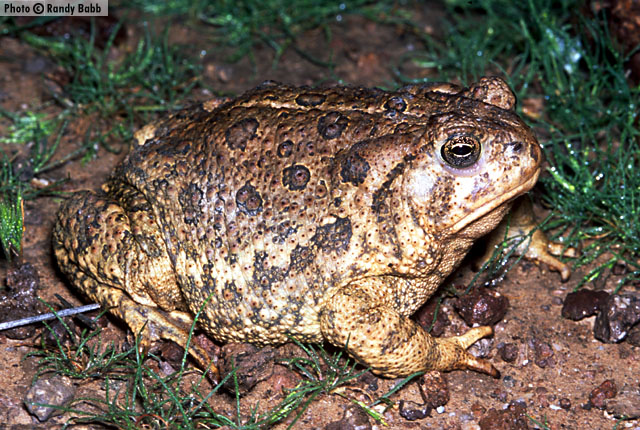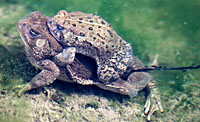Online Field Guide to The Reptiles and Amphibians of Arizona



Maricopa County, AZ
 Amplexus & eggs. Yuma Co., AZ |
| WOODHOUSE’S TOAD Anaxyrus woodhousii | |
|
DESCRIPTION: Up to 5 inches in length, this toad can be distinguished from other frogs and toads by its rough, warty skin, a whitish stripe down the middle of the back, and elongated parotoid glands on each side of the back of the head. This is usually a light brown or yellowish-brown toad with dark blotches and prominent cranial crests between and in front of the eyes. Males average a smaller size than females, have smoother skin, and possess a dark throat that is most noticeable during the breeding season. Tadpoles are dark brown, gray, or black, often with light mottling; the underside of the tail is lighter colored. Maximum tadpole length is about 1.2 inch. Hybridization with the Arizona Toad and the Red-spotted Toad has been noted. DISTRIBUTION: Occurs throughout Arizona except for the arid, western deserts (away from rivers and croplands), and the highest montane areas. HABITAT: This species is found in a variety of wetland communities from along the Colorado River and in agriculture near Yuma to montane lakes above the Mogollon Rim. It prefers areas in and near ponded permanent water, such as backwaters and slack water of big rivers, lakes, and irrigation ditches and canals; but can also be found at cattle tanks and other seasonal wetlands in central and eastern Arizona. They can be encountered in backyards or foraging under streetlights in rural or urban areas near such habitats. BEHAVIOR: Mostly nocturnal, but juveniles are sometimes found active during the day. In the western deserts, Woodhouse’s toads stay close to breeding ponds and adjacent wetted habitats. But in central and eastern Arizona, and at higher elevations, they may wander far from water after the breeding season. REPRODUCTION AND CALLS: Along rivers, in agriculture, and at other permanent water in the deserts, breeding occurs as early as February and continues into June. Breeding occurs later at higher elevations, and at ephemeral ponds filled by the summer monsoons, the species breeds from June to September. The call is a nasal “waaah!” resembling the call of a sheep and is given by males in shallow water or on land near the water’s edge. Calls are loud and audible over long distances. Up to 28,000 eggs are deposited in long stringers. Tadpoles metamorphose in 5-8 weeks. DIET: Woodhouse’s toads eat a variety of arthropods, such as sowbugs, scorpions, bees, insect larvae, ants, and spiders. REMARKS: This is one of very few native anurans that coexist well with American bullfrogs, crayfish, and a variety of introduced fishes. It is common on the lower Colorado River and in southern Arizona croplands despite the presence of non-native predators. It is apparently unpalatable to largemouth bass and some other predators. It is expanding its range or becoming more predominant in some areas and has replaced the Arizona toad at several locations. Two subspecies are currently recognized in Arizona, including the Southwestern Woodhouse’s toad (A. w. australis) from southern Arizona, and the Rocky Mountain Woodhouse’s toad (A. w. woodhousei) found in northern Arizona. By Jim Rorabaugh Brennan, T.C., and A.T. Holycross. 2006. A Field Guide to Amphibians and Reptiles in Arizona. Arizona Game and Fish Department. Phoenix, AZ. Sullivan, B.K. 2005. Bufo woodhousei Girard, 1854 Woodhouse’s toad. Pages 438-440 in M.J. Lannoo (ed), Amphibian Declines: The Conservation Status of United States Species. University of California Press, Berkeley, CA. Sullivan, B.K. 1989. Desert environments and the structure of anuran mating systems. Journal of Arid Environments 17(2):175-183. Stebbins, R.C. 1962. Amphibians of Western North America. University of California Press, Berkeley, CA. |
|
Visit Partners in Amphibian and Reptile Conservation:


HOME
Copyright © 2023, Arizona Game and Fish Department. All rights reserved.
If you make use of the textual contents of this site in reports, publications, etc. please cite and credit the author(s) and photographer(s). All photos on this website are copyrighted. However, those found in the species account section may be used for any noncommercial scientific, educational, or conservation purposes provided that photographs are not altered and continue to bear the copyright symbol and name of the photographer. Please contact the photographer regarding commercial use of copyrighted photographs.










